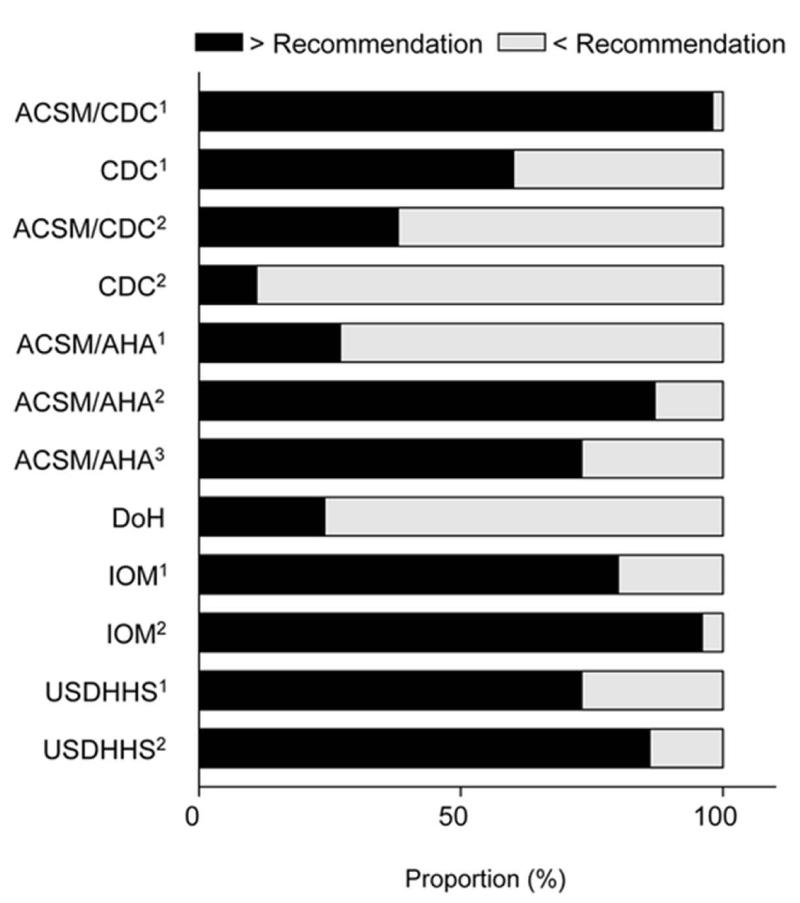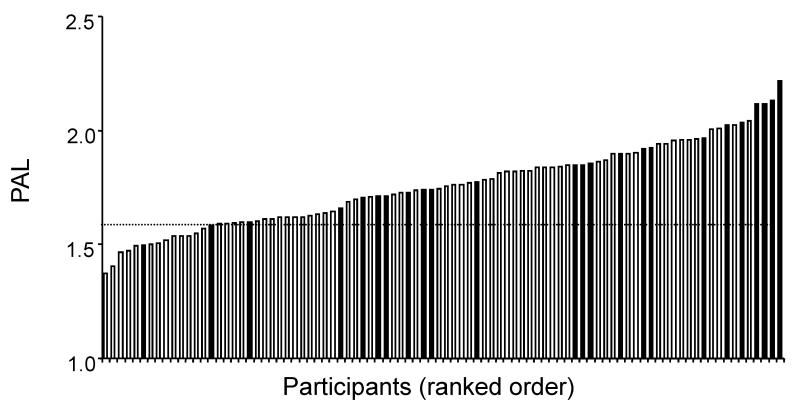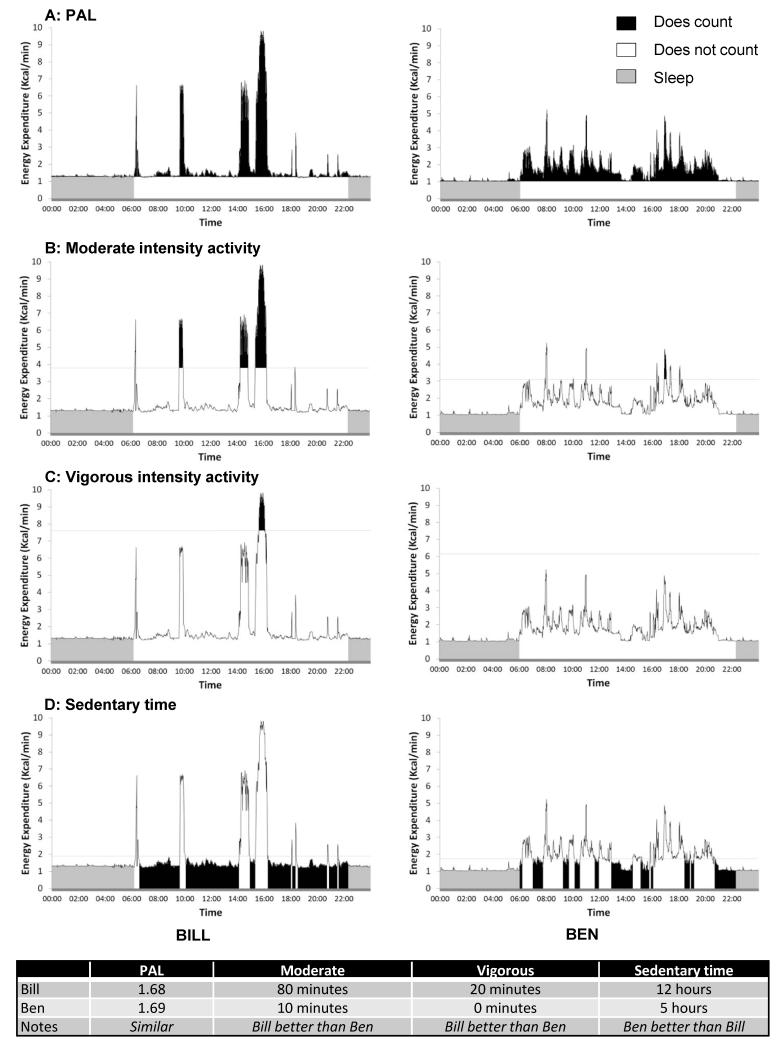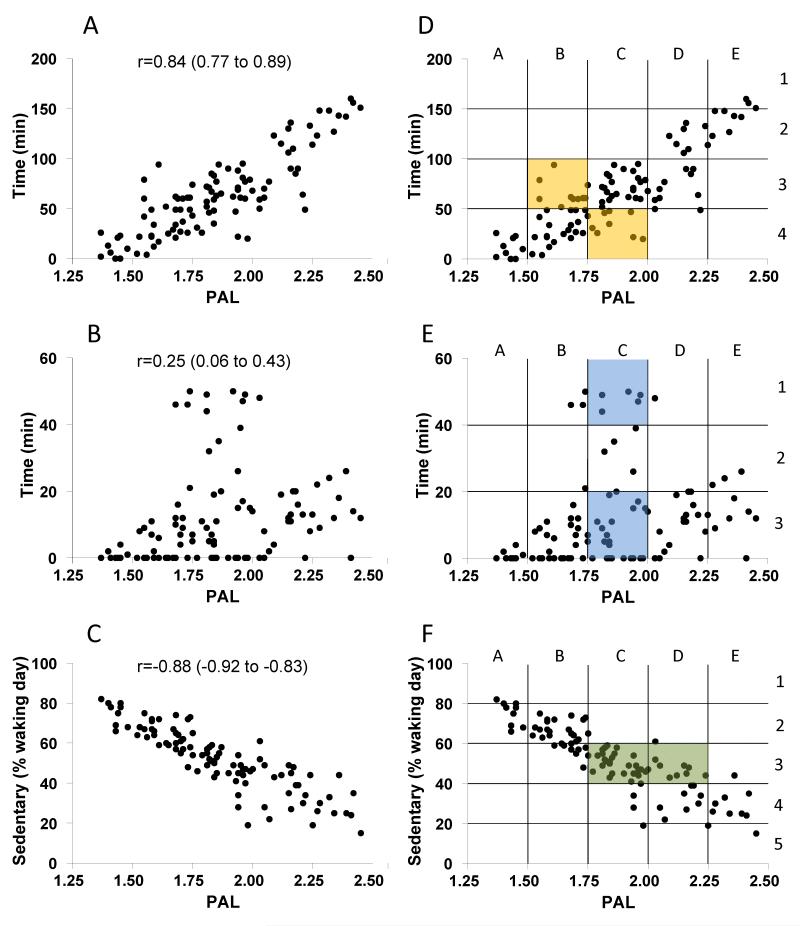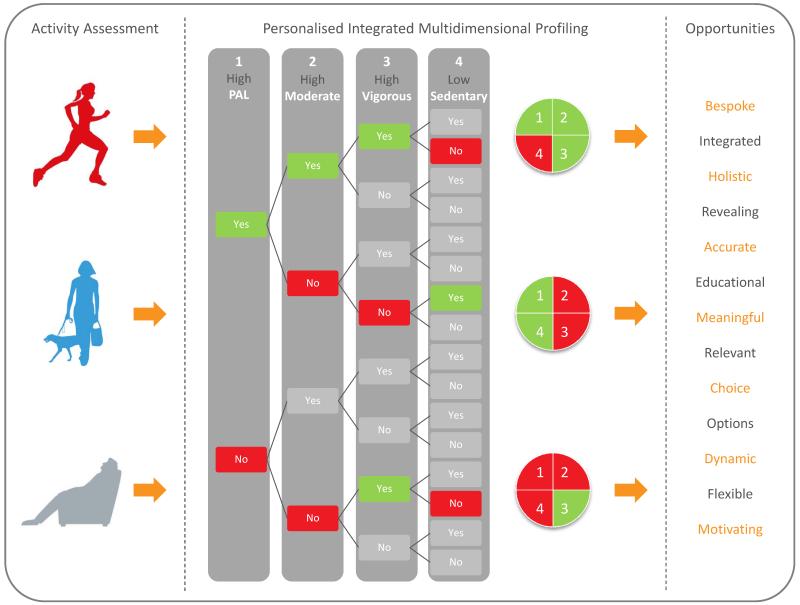Abstract
Our research shows that no single metric will adequately reflect an individual’s physical activity because multiple biologically-important dimensions are independent and unrelated. We propose that there is an opportunity to exploit this multidimensional characteristic of physical activity in order to improve personalised feedback and offer physical activity options and choices that are tailored to an individual’s needs and preferences.
Keywords: Physical activity status, physical activity recommendations, physical activity monitoring, physical activity energy expenditure, physical activity patterns
INTRODUCTION
In the past 5-10 years, there has been an explosion in the availability of technologies for the general public to monitor and receive feedback on their physical activity. Many major international companies have entered this market and self-monitoring of physical activity is available to millions of people around the world – including patients who are being counselled about the need to increase their physical activity. It is inevitable that technological advances in the next generation of widely available physical activity monitors will be extremely rapid. Commercial devices from major international companies such as Apple, Garmin, Microsoft, Nike, Philips, Samsung, Fitbit, and Jawbone are all currently available. Thus, we are entering an era where the capture of free-living physical activity energy expenditure will become more-and-more accessible and commonplace. In this new era, we hypothesise that it will be important to improve the way in which these data are used and portrayed in order to provide a more accurate and integrated picture of an individual’s physical activity that cuts across the biologically important dimensions – as well as using this information to offer people a smörgåsbord of physical activity options and choices.
SAME RAW ENERGY EXPENDITURE DATA, DIFFERENT PHYSICAL ACTIVITY STATUS
In principle, it should be straightforward for individuals to use technology to self-monitor and answer what appears a simple question “Am I doing enough of the right kind of physical activity for health?”. However, our research using sophisticated measurement instruments shows that providing an unambiguous answer to this question is far from straightforward (27). In this study, we set out to perform what we thought would be a simple task – to take data using a device which has been shown to accurate and precise and determine whether an individual met recommended levels of physical activity (27). Part of our initial motivation was to be able to give people who took part in our research studies a clear message about whether they were doing an adequate amount of physical activity for health. We examined a number of recommendations from various agencies and organizations to examine the extent of variability in physical activity status according to recommendation. We were very surprised to find that up to 90% of men could be described as either active or insufficiently active based on the same physical activity energy expenditure data (Figure 1). This means that, in response to our simple question, nine out of every ten people would get an answer that was something like ‘yes’, ‘no’, or ‘it depends’.
Figure 1.
The proportion of middle-aged men in this sample who either met or failed to meet each of the 12 recommendations included in this analysis. A full description of these recommendations has been provided previously (27). Briefly, we included recommendations and various versions of recommendations from the American College of Sports Medicine (ACSM), Center for Disease Control (CDC), American Heart Association (AHA), UK Department of Health (DoH), Institute of Medicine (IOM) and US Department of Health and Human Services (USDHHS).
The discrepancy highlighted in Figure 1 is based on a post hoc analysis of the same raw data and thus this disagreement and inconsistency is unrelated to errors at the data capture stage (27). It is also not due to an unrepresentative study sample – this group of middle-aged men had an energy expenditure from physical activity which was similar to the median reported in the UK (23). Instead, it appears that the required dose of physical activity and/or the way in which it is expressed has a powerful effect on apparent physical activity status. One example from this study is illustrated in Figure 2 which shows normalised physical activity energy expenditure (Physical Activity Level or PAL) and a recommendation that uses time engaged in moderate to vigorous intensity physical activity. As demonstrated in the example in this figure, some people can accumulate considerable energy expenditure through physical activity without also meeting the time/intensity based recommendation (and vice versa).
Figure 2.
One example of the discrepancy at the individual level between different physical activity recommendations based upon different physical activity characteristics (27). Ranked individual data for physical activity energy expenditure is expressed as Physical Activity Level or PAL (Total Energy expenditure/Basal Metabolic Rate). The horizontal dashed line indicates a PAL-specific threshold of 1.6 (i.e., from the Institute of Medicine) whereas the shaded columns indicate where this specific participant also met the time/intensity recommendation from ACSM/AHA (i.e., either 5 days of moderate intensity activity or 3 days of vigorous activity per week).
Therefore, it is possible to take the same raw data for physical activity energy expenditure and form very contrasting views about whether a given individual is active or insufficiently active if we base our interpretation on one recommendation instead of another. This has clear implications for the public and practitioners – especially over the next decade as commercially-available monitoring technologies move towards an accuracy and precision similar to the research instruments that we used. Although some of the discrepancies were associated with imprecision in the construction or communication of a given physical activity recommendation, the biggest differences were due to the fact that different recommendations draw on different physical activity characteristics. Figure 3 demonstrates how the way in which these key characteristics are extracted from daily energy expenditure data will influence the picture that emerges. These kinds of characteristics often form the basis for specific physical activity recommendations – for example, the Institute of Medicine focuses primarily on normalised physical activity energy expenditure (PAL) whereas other recommendations use time engaged in activity of a specific intensity (1). Thus, a major cause of the discrepancy depicted in Figures 1 and 2 appears to come down to philosophical differences in terms of the type of physical activity that ‘counts’.
Figure 3.
Physical activity energy expenditure analysed and dissected according to a few selected potentially important physical activity characteristics and dimensions. In this example, two individuals have similar scores for overall physical activity energy expenditure but they have accumulated physical activity in very different ways. A, Physical Activity Level (PAL); B, time engaged in physical activity > 3 metabolic equivalents (METs) accumulated in bouts of at least 10 min; C, time engaged in physical activity > 6 METs; D, time spent below 1.5 METs (sedentary time). As demonstrated in the summary, using one descriptor alone and in isolation will lead to a very different picture regarding physical activity status.
PHYSICAL ACTIVITY IS MULTIDIMENSIONAL
It is quite reasonable to carve up physical activity energy expenditure in different ways depending on a given perspective or paradigm. However, it is also reasonable to anticipate that this could impact upon the message that an individual receives. In a recent paper, we set out to explore the extent of any heterogeneity in terms of some of the physiologically-important physical activity dimensions which ‘count’ towards health (26). Our aim was quite simple – we wanted to determine the extent to which people score consistently or variably in terms of different potentially-important physical activity dimensions/characteristics. There is ongoing uncertainty about the various dimensions which are biologically relevant and important for health but one key dimension is overall physical activity energy expenditure which is naturally the most important consideration for weight loss or maintenance (16). However, other specific forms of physical activity generate profound health-related benefits that are unrelated to overall energy expenditure and energy balance – and these should also be considered (3, 11-13, 18, 32). As a further example of the exclusive nature of the different physical activity dimensions, a recent meta-analysis shows how sedentary time impacts upon risk of cancer even after adjustment for physical activity (22). Importantly, our analysis demonstrates that there is considerable heterogeneity across physical activity dimensions that have been shown to be physiologically important (26). Indeed, individuals who ostensibly appear similar for one physical activity measure (e.g., time engaged in moderate intensity physical activity) can score very differently for other metrics (e.g., overall physical activity energy expenditure). Only a very few people score consistently across all physical activity dimensions (26). Several authors had previously proposed that there are conceptual differences in selected physical activity dimensions (10, 20, 29), but this had not been tested empirically and across some of the key (multiple) dimensions known to exert potentially powerful effects on health.
Some of the results from this analysis are shown in Figure 4 (26). In spite of a very large correlation between normalised physical activity energy expenditure (PAL) and time engaged in moderate intensity physical activity, the coloured quadrants illustrate and highlight the message a given group of individuals would receive if they were to be provided with one physical activity descriptor alone (Figure 4, D). In this case, there is a group of men in quadrant B3 who score highly for time engaged in moderate intensity physical activity but relatively poorly for physical activity energy expenditure (i.e., lower scores for PAL) than the group in quadrant C4 who have higher scores for PAL but without as much moderate intensity physical activity. The same thing applies for vigorous intensity physical activity where there is a clear difference in scores for time engaged in vigorous intensity physical activity between groups that have a similar PAL (Figure 4, E). In Figure 4 (F), we illustrate how two groups of people look similar for sedentary time but different for overall physical activity energy expenditure (PAL). Clearly, if we provided these individuals with only one physical activity score then they would form an incomplete or inaccurate picture of their overall physical activity. The solution to such potential misclassification is to avoid the reliance on just one physical activity outcome or descriptor.
Figure 4.
Heterogeneity in physical activity across various physical activity dimensions (26). A, PAL versus daily time engaged in physical activity > 3 METs accumulated in bouts of at least 10 min; B, PAL versus daily time engaged in physical activity > 7.2 METs accumulated in bouts of at least 10 min; C, PAL versus daily time engaged in sedentary activities as a proportion of the waking day (i.e., below 1.5 METs accumulated on a minute-to-minute basis). Pearson correlations with 95% confidence intervals are reported. D-E shows the same relationships but with quadrants superimposed and highlighted (see text for details).
Thus, with the expansion of technology-enabled feedback aimed at individuals and consumers, there is the danger that many people will form an erroneous opinion about their physical activity if they are guided to focus on one physical activity dimension alone. We propose that it is unlikely that there is a single outcome or descriptor which reflects all the relevant information about physical activity – and that, instead, we need to capture physical activity ‘profiles’ across the physiologically-important dimensions.
MULTIDIMENSIONAL PHYSICAL ACTIVITY: IMPLICATIONS FOR RESEARCHERS
Based on the above discussion, physical activity is much more interesting than simply ‘high’ versus ‘low’ – a situation not dissimilar to the multiple aspects of diet that are known to be important. We propose that we should avoid collapsing the thousands of data points generated by physical activity measurement technologies into a single outcome measure that we call ‘physical activity’. This might initially seem like a headache for epidemiologists in that it is more convenient to treat physical activity as a single exposure or outcome. However, this is familiar territory and there will be innovative solutions. For example, we previously proposed that it may be possible to learn from parallel situations such as the metabolic syndrome where multiple inputs are used to generate a criterion-based score for physical activity (26). It may even be possible to determine the absence of any healthful physical activity across the key dimensions and we might call this something like the ‘Physical Inactivity Syndrome’ (26). Alternatively, we might develop an iterative classification system based on scores in each dimension in order to build an integrated profile. Clearly, such a system is untested and there are important questions to be tackled. For example, are all dimensions equally important and/or are there other physical activity dimensions that have not been identified? Two particularly good examples of emerging dimensions which might need to be considered in the future comes from studies showing the powerful effect of very brief periods of high intensity physical activity (18) and the impact of relatively small amounts of light-to-moderate intensity activities distributed throughout the day (2, 4, 5).
Taking a multidimensional approach to physical activity also has implications for researchers conducting trials of physical activity or exercise training interventions. For example, if participants are recruited based on the absence or presence of a specific score in a particular pre-defined physical activity dimension (e.g., high sedentary time), this could ignore other differences in physical activity phenotype which could influence the response to a given intervention. We have previously proposed that this may explain at least some of the heterogeneity in response to classical exercise training studies such as HERITAGE (25, 26). To illustrate this point, if two recruited participants score similarly and poorly for one (measured) physical activity dimension or parameter that is used as the basis for recruitment but they also score differently for another (unmeasured) parameter then we cannot conclude that any divergent response between individuals to a standardised exercise stimulus reflects genotypic differences. The divergent response could be partly due to differences in pre-intervention physical activity phenotype – which were not measured or used as a basis for inclusion.
MULTIDIMENSIONAL PHYSICAL ACTIVITY IS AN OPPORTUNITY NOT A PROBLEM
A multidimensional approach to physical activity creates future opportunities for researchers but we feel that the most immediate benefit will be for the public and technology companies. In addition to offering a more integrated and complete view of physical activity, a key opportunity which arises from the provision of a multidimensional picture is that it offers a smörgåsbord of physical activity options and choices that can be tailored to an individual’s needs and preferences. A multidimensional physical activity profile helps to focus feedback on the individual’s perspective and takes a more holistic view. Even the simplest version has advantages over a more unidimensional approach (Figure 5).
Figure 5.
A simple representation for physical activity profiles across selected physiologically-important dimensions. As described previously (26), each profile captures five different physical activity dimensions for five participants and demonstrates how a multidimensional profile is more revealing than a unidimensional score. For example, participants 2 and 8 have similar physical activity energy expenditure (PAL) but differ for other dimensions which could be important for health. Participants 28 and 75 are similar for sedentary time but differ for many of the other dimensions (including PAL). In this simple iteration, we have used green/red to indicate the clear achievement/failure to achieve each threshold; with amber indicating that values were within 20% of the target value.
Multidimensional Physical activity profiles: a powerful stimulus for sustained change?
A multidimensional representation of physical activity will provide a more accurate depiction of physical activity that reduces the chance of misclassification and/or misinformation. It is more educational and provides a better and more holistic representation of physical activity. For example, many people overestimate their own physical activity and are thus less likely to intend to change, or even have an awareness of the need to change, their behaviour (31). Part of the problem is that people sometimes focus on just certain physical activity behaviours without taking into account other dimensions. For example, many forms of structured physical activity have only a small thermogenic effect so that total energy expenditure is minimally affected by participation (30). This might not be so important for some specific metabolic and health benefits – but it is important for the individual to know why they are not losing (or possibly even gaining) weight; and weight loss will be critically important for some health outcomes and personal goals. The deeper understanding provided by a multidimensional physical activity profile will be more revealing and potentially more persuasive. For example, rather than receiving a single physical activity score, the provision of a multidimensional profile will demonstrate how some people are failing to make use of any of multiple ways in which physical activity can impact upon health (e.g., participant 2 in Figure 5). If an individual in this situation chooses to undertake moderate to vigorous intensity physical activity then this should be applauded – but it might have only a modest impact on sedentary time or overall energy expenditure. Similarly, if they choose to reduce their sedentary time then this is unlikely to impact upon some of the other dimensions. Clearly, the capture and provision of feedback across these physical activity dimensions will be more useful and revealing than the reliance on a single outcome or continuum.
An understanding of personalised physical activity is integral to various models of behaviour change and regulation (15, 33). Moreover, the diverse physical activity options and choices associated with multidimensional physical activity profiling creates an exploitable social marketing opportunity. The marketing of personalised physical activity profiling is potentially a key step towards greater empowerment (or self-determined engagement) via the support of autonomy and competence. When patients experience autonomy and competence in their treatment they experience greater volitional engagement and demonstrate greater maintenance of desirable health behaviours (21). With a multidimensional profile, the options for physical activity can be flexible and dynamic – with the opportunity to target different dimensions at different times.
For the healthcare practitioner, advice can be tailored to the individual (i.e., context-specific guidance such as physical activity for weight loss) and this advice is more likely to be perceived as being personally relevant and meaningful. In the future, it is possible that different people might be encouraged to do different things depending on genotype/phenotype. For example, targeting glucose control in people with type 2 diabetes might benefit more from focussing on certain physical activity dimensions rather than on others. It is clearly too early to say at present, but there are already signs that this might be the case (8).
Multidimensional Physical activity profiles: a helpful prop during transition?
The effectiveness of physical activity interventions ultimately relies on the net change in a given physical activity dimension(s). In the case of energy expenditure, the introduction of ‘new’ physical activity will (inevitably) substitute for some other activity (probably of a lower intensity) so that the net effect is smaller than the effect predicted from the novel activity alone (28, 30). There is also the possibility that some people compensate for an increase in one type of physical activity behaviour by decreasing another (9). These factors can mean that in spite of the introduction of a novel behaviour there is no net effect on total energy expenditure (30). Of course, providing a clear multidimensional picture will help people to understand how even a substantial change in one physical activity dimension might not have much of an effect on other dimensions. This improved awareness will allow people to take greater responsibility for managing their physical activity – which will contribute to greater self-determination via support for an individual’s sense of autonomy and competence (21, 24). Feedback and support in the form of a multidimensional physical activity profile allows an understanding of what has been realised, what is achievable and in what timescale.
As summarised and illustrated in Figure 6, a multidimensional approach to physical activity provides a more integrated picture and creates many inter-related opportunities. We have recently begun a trial which draws on technology-enabled self-monitoring using multidimensional physical activity feedback in at-risk men and women as part of the Mi-PACT project (19).
Figure 6.
A schematic illustrating some of the advantages and opportunities from multidimensional physical activity profiling. This theoretical depiction includes three individuals with distinct physical activity patterns coupled to a simple iterative process to build a basic profile across four physical activity dimensions. Even this simple approach produces opportunities – and more sophisticated profiles will be able to include other considerations such as magnitude based scores and/or performance in other physical activity dimensions.
At present, many commercially-available devices might not capture information with sufficient resolution to reflect the different physical activity dimensions. However, the accuracy and precision of these technologies will improve and there are already some commercially-available instruments with excellent reported validity (14, 34). The future will bring tremendous opportunities to use the information from these emerging technologies to help people engage and sustain appropriate physical activity.
Data visualisation and design of web-based applications
An exciting challenge will be the communication of multidimensional physical activity data in a way that is readily understandable as well as informative and motivating. One risk is that people could find multidimensional physical activity to be complicated and difficult to comprehend. In this context, when data is potentially complex or intangible, visualisations have a fundamental role in helping to foster understanding (6, 17). Approaches to communicating multidimensional physical activity information could use graphics and exploratory web-based applications linking data and visualisations with an interactive platform (7). It is unlikely that there will be a definitive design solution to meet the needs of everyone and, given the diversity of the potential audience, user-centred and participatory approaches that involve stakeholders in the design process will be required to ensure that the diversity of user needs are met.
CONCLUSION
We now have the necessary tools and techniques to capture and generate an integrated and well-rounded picture for an individual’s physical activity. This approach reduces the risk of people forming an erroneous conclusion about their physical activity status because it recognises that there are multiple ways in which to benefit from physical activity. Furthermore, in addition to being more educational and informative, a multidimensional physical activity profile can be used to produce a smörgåsbord of physical activity options and choices rather than a single one-size-fits-all recommendation. This approach firmly focuses on the individual at the centre as a user of information in control of their personal physical activity and, as technology becomes more accessible and affordable, there are exciting opportunities to be exploited.
ACKNOWLEDGEMENTS
Funding for the work described in this review was provided in part by the National Prevention Research Initiative (MR/J00040X/1). Funding partners are: Alzheimer’s Research Trust, Alzheimer’s Society, Biotechnology and Biological Sciences Research Council, British Heart Foundation; Cancer Research UK; Chief Scientist Office, Scottish Government Health Directorate; Department of Health; Diabetes UK; Economic and Social Research Council; Health and Social Care Research and Development Division of the Public Health Agency; Medical Research Council; The Stroke Association; Wellcome Trust; Welsh Assembly Government and World Cancer Research Fund.
Funding Disclosure: Funding was provided in part by the National Prevention Research Initiative. Funding partners are: Alzheimer’s Research Trust, Alzheimer’s Society, Biotechnology and Biological Sciences Research Council, British Heart Foundation; Cancer Research UK; Chief Scientist Office, Scottish Government Health Directorate; Department of Health; Diabetes UK; Economic and Social Research Council; Health and Social Care Research and Development Division of the Public Health Agency; Medical Research Council; The Stroke Association; Wellcome Trust; Welsh Assembly Government and World Cancer Research Fund.
Footnotes
Conflicts of Interest: The authors have no conflicts of interest to declare
References
- (1).Brooks GA, Butte NF, Rand WM, Flatt JP, Caballero B. Chronicle of the institute of medicine physical activity recommendation: How a physical activity recommendation came to be among dietary recommendations. American Journal of Clinical Nutrition. 2004;79(5):921–30. doi: 10.1093/ajcn/79.5.921S. [DOI] [PubMed] [Google Scholar]
- (2).Buman MP, Hekler EB, Haskell WL, Pruitt L, Conway TL, Cain KL, Sallis JF, Saelens BE, Frank LD, King AC. Objective light-intensity physical activity associations with rated health in older adults. Am J Epidemiol. 2010;172(10):1155–65. doi: 10.1093/aje/kwq249. [DOI] [PMC free article] [PubMed] [Google Scholar]
- (3).Burgomaster KA, Howarth KR, Phillips SM, Rakobowchuk M, MacDonald MJ, McGee SL, Gibala MJ. Similar metabolic adaptations during exercise after low volume sprint interval and traditional endurance training in humans. Journal of Physiology-London. 2008;586(1):151–60. doi: 10.1113/jphysiol.2007.142109. [DOI] [PMC free article] [PubMed] [Google Scholar]
- (4).Carson V, Ridgers ND, Howard BJ, Winkler EAH, Healy GN, Owen N, Dunstan DW, Salmon J. Light-intensity physical activity and cardiometabolic biomarkers in us adolescents. PLoS ONE. 2013;8(8):e71417. doi: 10.1371/journal.pone.0071417. [DOI] [PMC free article] [PubMed] [Google Scholar]
- (5).Dunstan DW, Kingwell BA, Larsen R, Healy GN, Cerin E, Hamilton MT, Shaw JE, Bertovic DA, Zimmet PZ, Salmon J, Owen N. Breaking up prolonged sitting reduces postprandial glucose and insulin responses. Diabetes Care. 2012;35(5):976–83. doi: 10.2337/dc11-1931. [DOI] [PMC free article] [PubMed] [Google Scholar]
- (6).Evanko D. Supplement on visualizing biological data. Nature Methods. 2010;7(3):193. doi: 10.1038/nmeth0310-s1. [DOI] [PubMed] [Google Scholar]
- (7).Fox P, Hendler J. Changing the equation on scientific data visualization. Science. 2011;331(6018):705–8. doi: 10.1126/science.1197654. [DOI] [PubMed] [Google Scholar]
- (8).Francois M, Baldi J, Manning P, Lucas SE, Hawley J, Williams MA, Cotter J. ‘Exercise snacks’ before meals: A novel strategy to improve glycaemic control in individuals with insulin resistance. Diabetologia. 2014;57(7):1437–45. doi: 10.1007/s00125-014-3244-6. [DOI] [PubMed] [Google Scholar]
- (9).Gomersall SR, Rowlands AV, English C, Maher C, Olds TS. The activitystat hypothesis: The concept, the evidence and the methodologies. Sports medicine (Auckland, N.Z.) 2013;43(2):135–49. doi: 10.1007/s40279-012-0008-7. [DOI] [PubMed] [Google Scholar]
- (10).Hamilton MT, Hamilton DG, Zderic TW. Role of low energy expenditure and sitting in obesity, metabolic syndrome, type 2 diabetes, and cardiovascular disease. Diabetes. 2007;56(11):2655–67. doi: 10.2337/db07-0882. [DOI] [PubMed] [Google Scholar]
- (11).Healy GN, Matthews CE, Dunstan DW, Winkler EAH, Owen N. Sedentary time and cardio-metabolic biomarkers in us adults: Nhanes 2003-06. European Heart Journal. 2011;32(5):590–7. doi: 10.1093/eurheartj/ehq451. [DOI] [PMC free article] [PubMed] [Google Scholar]
- (12).Healy GN, Wijndaele K, Dunstan DW, Shaw JE, Salmon J, Zimmet PZ, Owen N. Objectively measured sedentary time, physical activity, and metabolic risk. Diabetes Care. 2008;31(2):369–71. doi: 10.2337/dc07-1795. [DOI] [PubMed] [Google Scholar]
- (13).Helmerhorst HJF, Wijndaele K, Brage S, Wareham NJ, Ekelund U. Objectively measured sedentary time may predict insulin resistance independent of moderate- and vigorous-intensity physical activity. Diabetes. 2009;58(8):1776–9. doi: 10.2337/db08-1773. [DOI] [PMC free article] [PubMed] [Google Scholar]
- (14).Johannsen DL, Calabro MA, Stewart J, Franke W, Rood JC, Welk GJ. Accuracy of armband monitors for measuring daily energy expenditure in healthy adults. Med Sci Sports Exerc. 2010;42(11):2134–40. doi: 10.1249/MSS.0b013e3181e0b3ff. [DOI] [PubMed] [Google Scholar]
- (15).Kirschenbaum DS. Self-regulatory failure - a review with clinical implications. Clinical Psychology Review. 1987;7(1):77–104. [Google Scholar]
- (16).Levine JA, Vander Weg MW, Hill JO, Klesges RC. Non-exercise activity thermogenesis. Arteriosclerosis, Thrombosis, and Vascular Biology. 2006;26(4):729–36. doi: 10.1161/01.ATV.0000205848.83210.73. [DOI] [PubMed] [Google Scholar]
- (17).McInerny GJ, Chen M, Freeman R, Gavaghan D, Meyer M, Rowland F, Spiegelhalter DJ, Stefaner M, Tessarolo G, Hortal J. Information visualisation for science and policy: Engaging users and avoiding bias. Trends in Ecology & Evolution. 2014;29(3):148–57. doi: 10.1016/j.tree.2014.01.003. [DOI] [PubMed] [Google Scholar]
- (18).Metcalfe R, Babraj J, Fawkner S, Vollaard N. Towards the minimal amount of exercise for improving metabolic health: Beneficial effects of reduced-exertion high-intensity interval training. European Journal of Applied Physiology. 2012;112(7):2767–75. doi: 10.1007/s00421-011-2254-z. [DOI] [PubMed] [Google Scholar]
- (19).MiPACT Multidimensional individualised physical activity profiles for behaviour change using technology. 2013 [Google Scholar]
- (20).Pate RR, O’Neill JR, Lobelo F. The evolving definition of “sedentary”. Exercise and Sport Sciences Reviews. 2008;36(4):173–8. doi: 10.1097/JES.0b013e3181877d1a. [DOI] [PubMed] [Google Scholar]
- (21).Ryan RM, Patrick H, Deci EL, Williams GC. Facilitating health behaviour change and its maintenance: Interventions based on self-determination theory. European Health Psychologist. 2008;10(1):2–5. [Google Scholar]
- (22).Schmid D, Leitzmann MF. Television viewing and time spent sedentary in relation to cancer risk: A meta-analysis. Journal of the National Cancer Institute. 2014;106(7) doi: 10.1093/jnci/dju098. [DOI] [PubMed] [Google Scholar]
- (23).Scientific Advisory Committee on Nutrition . Dietary reference values for energy. Crown Copyright; 2011. [Google Scholar]
- (24).Standage M, Ryan RM. Self-determination theory and exercise motivation: Facilitating self-regulatory processes to support and maintain health and well-being. In: Roberts GC, Treasure DC, editors. Motivation in sport and exercise. Human Kinetics; 2011. [Google Scholar]
- (25).Thompson D. Physical activity for physiologists. Physiology News. 2013:32–5. [Google Scholar]
- (26).Thompson D, Batterham AM. Towards integrated physical activity profiling. PLoS ONE. 2013;8(2):e56427. doi: 10.1371/journal.pone.0056427. [DOI] [PMC free article] [PubMed] [Google Scholar]
- (27).Thompson D, Batterham AM, Markovitch D, Dixon NC, Lund AJS, Walhin J-P. Confusion and conflict in assessing the physical activity status of middle-aged men. PLoS ONE. 2009;4(2):e4337. doi: 10.1371/journal.pone.0004337. [DOI] [PMC free article] [PubMed] [Google Scholar]
- (28).Thompson D, Peacock OJ, Betts JA. Substitution and compensation erode the energy deficit from exercise interventions. Med Sci Sports Exerc. 2014;46(2):423. doi: 10.1249/MSS.0000000000000164. [DOI] [PubMed] [Google Scholar]
- (29).Tremblay MS, Colley RC, Saunders TJ, Healy GN, Owen N. Physiological and health implications of a sedentary lifestyle. Applied Physiology Nutrition and Metabolism-Physiologie Appliquee Nutrition Et Metabolisme. 2010;35(6):725–40. doi: 10.1139/H10-079. [DOI] [PubMed] [Google Scholar]
- (30).Turner JE, Markovitch D, Betts JA, Thompson D. Nonprescribed physical activity energy expenditure is maintained with structured exercise and implicates a compensatory increase in energy intake. Am J Clin Nutr. 2010;92(5):1009–16. doi: 10.3945/ajcn.2010.29471. [DOI] [PubMed] [Google Scholar]
- (31).van Sluijs EM, Griffin SJ, van Poppel MN. A cross-sectional study of awareness of physical activity: Associations with personal, behavioral and psychosocial factors. Int J Behav Nutr Phys Act. 2007;4:53. doi: 10.1186/1479-5868-4-53. [DOI] [PMC free article] [PubMed] [Google Scholar]
- (32).Walhin J-P, Richardson JD, Betts JA, Thompson D. Exercise counteracts the effects of short-term overfeeding and reduced physical activity independent of energy imbalance in healthy young men. The Journal of Physiology. 2013;591(24):6231–43. doi: 10.1113/jphysiol.2013.262709. [DOI] [PMC free article] [PubMed] [Google Scholar]
- (33).Weinstein ND, Rothman AJ, Sutton SR. Stage theories of health behavior: Conceptual and methodological issues. Health Psychology. 1998;17(3):290–9. doi: 10.1037//0278-6133.17.3.290. [DOI] [PubMed] [Google Scholar]
- (34).Welk GJ, McClain JJ, Eisenmann JC, Wickel EE. Field validation of the mti actigraph and bodymedia armband monitor using the ideea monitor. Obesity (Silver Spring) 2007;15(4):918–28. doi: 10.1038/oby.2007.624. [DOI] [PubMed] [Google Scholar]



